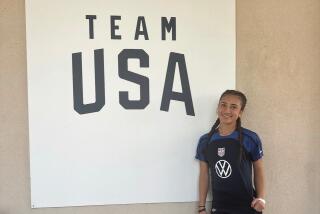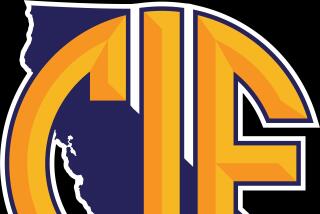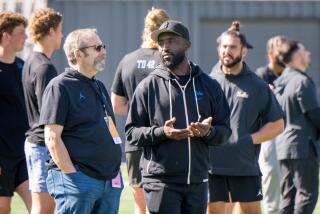This Jump Is One That Few Make
Thereâs one job for which even the best high school coach need not apply: college head coach.
It has become taboo, if not heresy, for a college athletic director to hire a high school coach for any of three high-profiled menâs positions: football, basketball, baseball.
Consider the plight of Tom Meusborn, the highly successful baseball coach at Chatsworth High, whose team had a state-record 50-game win streak when he applied last summer for the job at Cal State Los Angeles, an NCAA Division II school.
Meusborn couldnât get an interview because the minimum requirement in the job classification called for experience coaching at the college, professional or semipro level.
âItâs frustrating, itâs disappointing,â Meusborn said.
Mark Trakh understands the obstacles. He built a powerhouse girlsâ basketball program at Brea Olinda High in the 1980s, then started applying for college positions.
He was turned down at Cal State Fullerton, UC Irvine and Cal State L.A.
âIt got to the point when Pepperdine opened up, I said, âThis probably would be too difficult,â â Trakh said.
But a former Brea Olinda player at Pepperdine supported him, and two professors at Pepperdine whose daughter had played for him offered their endorsements. Athletic Director Wayne Wright gave him an interview and hired him as the womenâs coach in 1993.
âThey really took a chance, and Iâm forever indebted,â said Trakh, who coached for 11 years at Pepperdine before taking over at USC this past season. âLooking back on it, it was a difficult process.â
What Trakh encountered was skepticism about whether he could handle the recruiting challenges of college.
âI had to face, âWhy do you want to go to Pepperdine? They have no commitment to their program. They hired a high school coach,â â he said. âThat came from other college coaches.â
Trakh added, âTo be honest, I donât think I would have gotten the job today.â
This from a coach who, in his first season, guided the Trojans to their first NCAA tournament berth in eight years.
College athletics has become such big business that athletic directors are reluctant to risk hiring a high school coach.
âI would classify it as a challenge because they havenât had any experience in recruiting, no formal knowledge in NCAA rules and compliance, and sometimes theyâre not privy to academic requirements to get into college,â said Carol Dunn, Cal State L.A.âs athletic director. âNot that they couldnât learn it, but thereâs a huge learning curve.â
Perhaps no individual could have boosted the fortunes of high school coaches more than Gerry Faust, who was hired straight out of Cincinnati Moeller High in 1981 to be football coach at Notre Dame. He lasted until 1985, finishing with a record of 30-26-1.
His tenure was judged an experiment that failed.
âIâm sure if I had been real successful, it would have given others opportunities,â said Faust, who turns 70 in May and is a motivational speaker residing in Akron, Ohio.
Faust said recruiting issues were a primary topic in trying to enter the college ranks.
âRecruiting is probably the biggest barrier,â he said. âThat was the question I was asked. My answer was for 21 years at Moeller, every top college coach came by, and I used to watch. I donât think anyone was more exposed to recruiting than me.â
There was a time years ago when high school coaches were routinely considered for college jobs. John Wooden went from coaching high school basketball to Indiana State in 1946. Paul Brown was 80-8-2 as football coach at Massillon High in Ohio when he was hired by Ohio State in 1941.
College athletics has changed considerably. Dealing with the sophisticated world of recruiting, learning hundreds of pages of NCAA guidelines and adjusting to academic and social issues are the main obstacles high school coaches must overcome. Some have made the jump, but it doesnât happen often -- mostly in womenâs sports and Olympic menâs sports.
John Vargas was a successful water polo and swim coach at Corona del Mar High when he persuaded Stanford to hire him to coach its menâs water polo team. He guided the Cardinal to the NCAA title in his rookie season in 2002.
But Vargas had a big advantage: He sold Stanford on his experience coaching the U.S. national team from 1997 to 2000.
âBeing a national team coach, you had to be able to identify players, and thereâs some correlation in college recruiting,â he said. âI definitely had a plan how I was going to recruit. There are plenty of [high school] coaches down south and here that can definitely handle this level.â
But most of the head coaching jobs for menâs programs are being filled by college assistants.
Marcos âShakeyâ Rodriguez was a rare exception when he was hired at Florida International in 1996 after winning five state boysâ basketball titles at Miami High.
âFrom my perspective, I was in a situation that was kind of unique,â he said. âYou had a local Division I university who had tremendous problems drawing people. They kept bringing in guys from the Midwest, and it finally dawned on them they needed to get someone who could recruit locally and had some local ties, and it was more important than getting someone with experience.â
Rodriguez had a record of 79-66 before resigning after five seasons. Several off-the-court incidents involving players caused problems for him and his program.
âThe coaching part is easy,â he said.
âThe part that a high school coach has to learn and make an adjustment is understanding NCAA guidelines and understanding the technicalities of recruiting.â
Everyone seems to agree that some of the best teaching and coaching happens at the high school level. The trick is persuading a college athletic director to take a leap of faith.
More to Read
Get our high school sports newsletter
Prep Rally is devoted to the SoCal high school sports experience, bringing you scores, stories and a behind-the-scenes look at what makes prep sports so popular.
You may occasionally receive promotional content from the Los Angeles Times.







